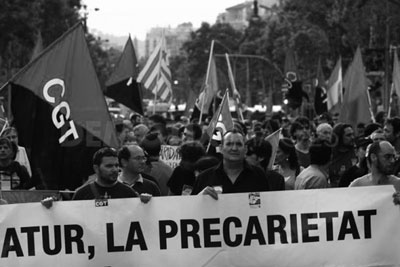Over 30 years of anarchist writing from Ireland listed under hundreds of topics
Spanish Celebrate 100 Years of Anarchist Trade Unionism
 2010 marks the 100th anniversary of the National Confederation of Labour (CNT), a militant anarchist union in Spain.
2010 marks the 100th anniversary of the National Confederation of Labour (CNT), a militant anarchist union in Spain.
When General Franco led his fascist revolt in 1936 workers rose up throughout the country, Where anarchist ideas were popular (as in Catalonia and Aragon) a social revolution occurred, showing that society could indeed function along anarchist lines. In hospitals, factories, mills, bus & train services, water & electricity, the workers of the CNT reorganised and administered production, distribution, and public services without bosses, managers, or the authority of the state.
More than 60% of agricultural land was collectively cultivated by the peasants themselves, without landlords, without bosses, and without any ‘need’ for capitalist competition to spur production. And in keeping with the CNT’s rejection of sexism women played a major part in the union, on the barricades and in the militia columns.
After Franco’s victory in 1939, the CNT continued the struggle underground and in exile. His death in 1975 saw the end of almost 40 years of dictatorship and the revival of the CNT. Unfortunately in 1979 there was a major division over whether or not to participate in the government’s proposed works councils*.
The problem is that people elected to these committees are not bound by any mandate, and it is seen as way of undermining unions in the workplace. Some insisted on a boycott and they kept the name CNT. Those who felt that not participating would mean marginalisation ended up as the CGT and Solidaridad Obrera.
Today anarchism is again growing in strength among working people in Spain. We can see this by looking at the 2.5 million union members in Spain, about 15% of all workers. This is much less than in Ireland, but in Spain most large and medium-sized firms have works councils. Every worker, not just union members, gets a vote. The unions put forward candidates, and their vote is a reflection of the support for a particular union’s position. Overall, about three quarters of the workforce take part and practically all vote for union candidates.
The two main trade unions, the CCOO and the UGT, have each about 800,000 members. The anarchist CGT has about 65,000 members, but in the last works council elections it received votes from over 1,000,000 workers who wanted the CGT to represent them. What makes this interesting is that it does not just show support for a more aggressive response to the employers’ offensive.
This is support for a union that makes no secret of its politics, one that rejects any form of ‘social partnership’ and constantly proclaims its anarchism. Nobody joining or voting for them could be unaware of their politics. Indeed their youth committees are called ‘Anarcho-Syndicalist Youth’.
The CNT is considerably smaller, but does have several thousand members in over 100 branches. A third union, Solidaridad Obrera, has members in Alicante, Menorca and a particularly visible presence in Madrid’s underground rail system. To mark the anniversary this union decided to give its members copies of José Peirats’ book ‘The CNT in the Spanish Revolution’.
As the crisis gets deeper and more of us face pay cuts, unemployment and uncertainty, the desirability of a better way of running society is undeniable. In Spain the ‘anarchist alternative’ is growing in popularity among those who want a socialist and truly democratic society.
* Comité de empresa. Elected every four years in workplaces with fifty or more employees to negotiate agreements with the employer. Elected representatives get time off to consult with the workforce and attend to union matters.

